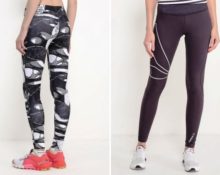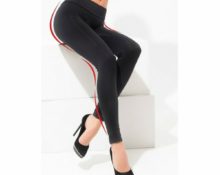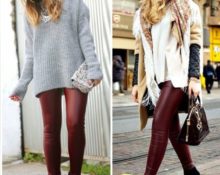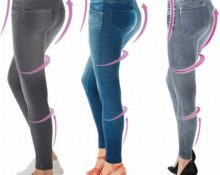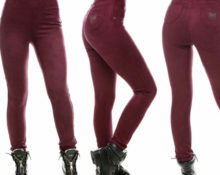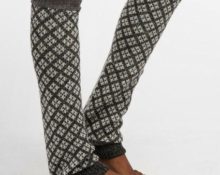In the modern world of fashion, leggings and jeggings are considered types of trouser products, and completely different ones. At first glance, some tight-fitting trousers and others differ little from each other, because in fact both models are leggings. And they have a lot in common, but there are many more differences.
Differences between jeggings and leggings
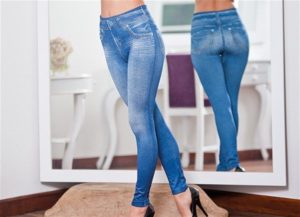 Jeggings are denim leggings. Fashionistas know another name for them - leggings. Jeggings and leggings are practical and versatile when it comes to pairing with clothes. Both slim-fit trouser styles help accentuate a small waist and accentuate your shapely hips and butt. But that's where their similarities ended.
Jeggings are denim leggings. Fashionistas know another name for them - leggings. Jeggings and leggings are practical and versatile when it comes to pairing with clothes. Both slim-fit trouser styles help accentuate a small waist and accentuate your shapely hips and butt. But that's where their similarities ended.
Jeggings differ from leggings:
- A denser texture, which allows you to maintain its shape without stretching the fabric.
- Material.
- The presence of decor in the form of buttons, buttons, fringe, lace or appliqué.
- The presence of denim fittings, colors and finishes.
Leggings, although considered tight-fitting trousers, are actually hosiery. Outwardly, they resemble tights without feet or gaiters. The women's wardrobe is complemented by tunics, skirts, and dresses. Also used as part of a sports uniform for fitness or dancing.
Important! Jeggings are an independent item of clothing. They are combined with short sweaters, turtlenecks, mini-dresses, sweaters, tunics, shirts, jackets and T-shirts and are worn like trousers, since they are a full imitation of jeans. Due to their convenience and practicality, leggings are used in oversized and casual styles.
Differences in style
Stylists identify four main styles of leggings:
 classic trousers, outwardly indistinguishable from jeans;
classic trousers, outwardly indistinguishable from jeans;- models with a black color scheme;
- slimming jeggings;
- cropped trousers with a length of seven-eighths or three-quarters;
- insulated models.
Legging styles are divided into 2 main groups depending on their purpose and design. The first group of models is:
- sports;
- thermal underwear
The design category is more extensive and includes:
 classic plain leggings;
classic plain leggings;- printed models;
- decorated trousers;
- winter insulated options;
- capris or breeches (short).
What the styles have in common are shortened models and insulated trousers. The remaining varieties of jeggings and leggings have nothing in common, and besides, leggings do not yet have such categories as thermal and sports.
What material is used when sewing jeggings and leggings?
In addition to denim and thickened knitwear, jeggings also use stretch fabric on a natural basis or with the addition of synthetic fibers.The presence of lycra, elastane and spandex in combination with cotton gives the material elasticity, due to which it can stretch while maintaining its shape.
Leggings have an unlimited number of bright colors and shades. There is also denim, but without the characteristic finishing elements. But for the manufacture of leggings, mainly knitwear and other natural fabrics are used.
What role does decor play?
Leggings often have “denim” decor in the form of:
- buttons and rivets;
- patch pockets;
- stitching;
- additional zippers in the side seams.
Jegging models are also decorated with appliqués, cuffs, buttons, rhinestones, lace and fringe.
Leggings cannot boast of such an abundance of decor. Often prints serve as decoration, less often inserts made of lace, leather or a combination of different fabrics.
Important! Decorated tight-fitting trousers help you choose clothes for a certain style and combine them advantageously with clothing items or accessories. Also, rhinestones or elegant appliqué allow you to use jeggings in a fashionable look for a special occasion.
The history of jeggings and leggings
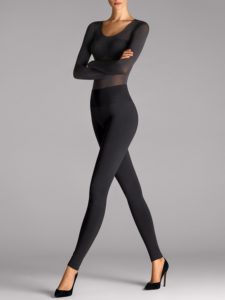 The prototype of leggings - tight-fitting trousers - have a very rich and eventful history and were originally considered men's clothing. They were given their modern look by Patricia Field about 40 years ago. But they appeared in the everyday women's wardrobe thanks to Karl Lagerfeld in the 80s of the last century. Despite the fact that tight knitted trousers had previously been used in fashion collections, it was his show that created a real sensation. Since then, leggings have appeared on women's legs, and high fashion periodically presents tight-fitting new items.
The prototype of leggings - tight-fitting trousers - have a very rich and eventful history and were originally considered men's clothing. They were given their modern look by Patricia Field about 40 years ago. But they appeared in the everyday women's wardrobe thanks to Karl Lagerfeld in the 80s of the last century. Despite the fact that tight knitted trousers had previously been used in fashion collections, it was his show that created a real sensation. Since then, leggings have appeared on women's legs, and high fashion periodically presents tight-fitting new items.
However, tight trousers became leggings a little later - in the mid-90s, when fashion designers began to use natural fabrics and muted colors. A decade later, this model experienced another revolution. Stylists suggested that the fair half should abandon tights in favor of tight-fitting trousers. And when sewing leggings, they began to use bold colors and various inserts and combinations.
In 2007, the House of Balenciaga presented a model for the spring-summer season worth 100 thousand dollars. Following the French, several more famous fashion designers offered new items made of leather and velvet. To keep up with competitors, designer Joe Dehan, who collaborated with the brand Joe's, proposed a model that was made of denim with elastane fibers.
To sew the new item, the finest fabric was used, soft and comfortable, presented in classic “denim” shades. These tight-fitting trousers immediately gained popularity and were called leggings or jeggings.
How do women's tight trousers differ from men's?
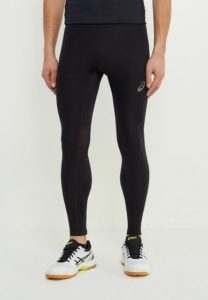 Modern fashion designers have developed tight pants not only for the fair sex, but also for the stronger half. The main difference between men's models and women's ones is the presence of an anatomical insert and a wide belt. Also, tight-fitting trousers for men have a less bright color palette and modest decor.
Modern fashion designers have developed tight pants not only for the fair sex, but also for the stronger half. The main difference between men's models and women's ones is the presence of an anatomical insert and a wide belt. Also, tight-fitting trousers for men have a less bright color palette and modest decor.
What fabrics are used to make women's leggings and jeggings?
Knitwear is most often used to sew women's leggings. Since these tight-fitting pants, reminiscent of women's tights, modern fashion designers also use:
- viscose;
- silk;
- melange;
- artificial leather;
- cotton;
- fine wool.
By adding microfiber, lycra, nylon and other elastic fibers, trousers made from such fabrics become tight-fitting and have good stretch. The only trouble is elongated knees and “ears” in the hip area.
For sewing jeggings, knitwear is also used, only thickened. Both denim and stretch fabric are based on denser threads than in the material used for leggings. Cotton is also used, but with the addition of synthetic fibers. Moreover, the proportion of synthetics in fabrics is over 30%, which makes the finished products softer, more stretchy and retaining their original shape. After wearing, leggings are not at risk of stretched knees and “ears”.
Nuances of men's analogues of women's leggings
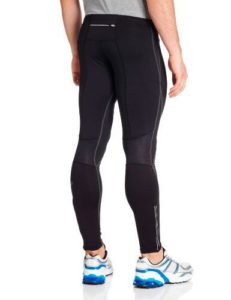 Men most often use leggings for sports and as underwear. Sports tight trousers come in a variety of sizes and formats, not to mention colors. When choosing men's analogues of women's leggings, you should pay attention to:
Men most often use leggings for sports and as underwear. Sports tight trousers come in a variety of sizes and formats, not to mention colors. When choosing men's analogues of women's leggings, you should pay attention to:
- the presence of ventilation inserts made of mesh material that prevent sweating and overheating of the skin;
- the presence of flat seams that prevent chafing of the skin;
- exact size match.
It is recommended to choose men's leggings from elastic fabrics that allow you to move freely. Although these are tight-fitting trousers, do not forget that you will have to walk, stand and breathe in them, so every man should feel comfortable.


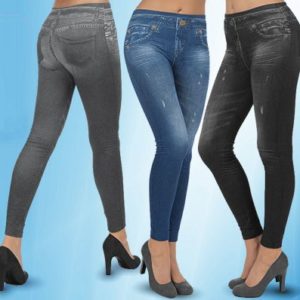
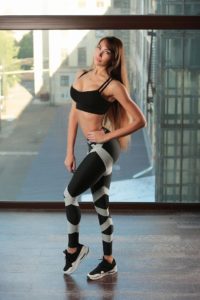
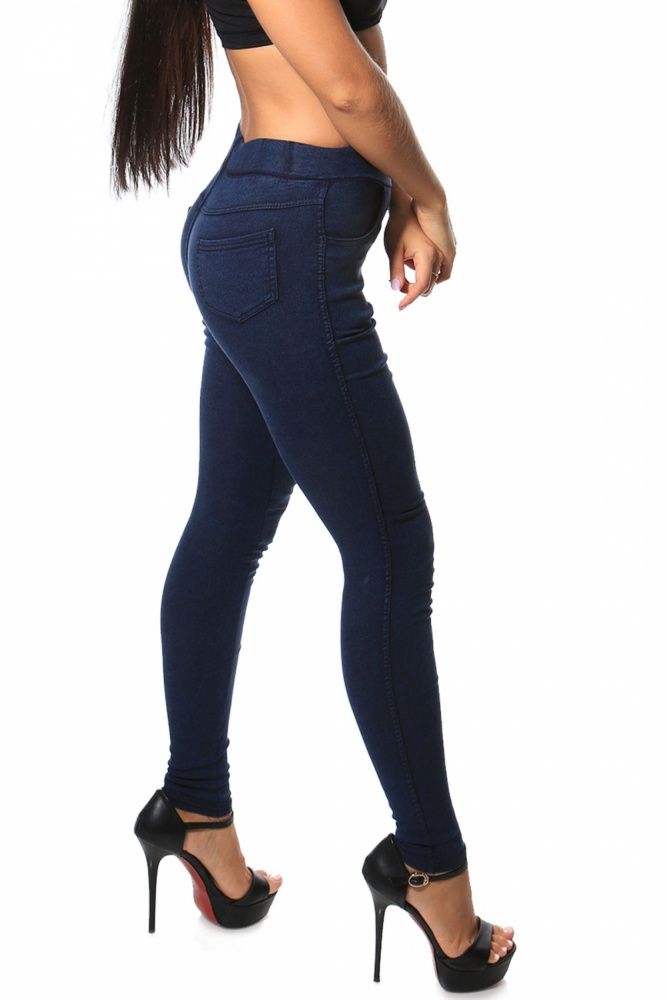
 0
0